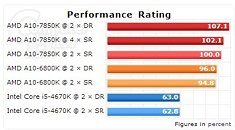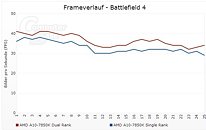Wednesday, January 22nd 2014

AMD A-Series "Kaveri" Performs Better with Dual-Rank DIMMs: Report
AMD's A-Series "Kaveri" APUs perform tangibly better on system with dual-rank memory modules, according to an investigative report by ComputerBase.de. According to the report, the chip yields its best memory bandwidth when both its memory channels are populated with 2-rank DIMMs each. Either that, or four modules with one rank each. The report also found out that Kaveri can take advantage of DDR3-2400 as advertised. There was a 15.2 percent jump in performance between DDR3-1866 and DDR3-2400.
An unreliable way of checking whether a DIMM has two ranks is by looking at whether both sides of its PCB has DRAM chips; a reliable way of doing that, however, is using software such as AIDA64 (Motherboard\SPD tab), which lists out number of ranks, and number of banks per rank; and of course, looking up the specs sheet. The reason visual inspection of a DIMM is not reliable these days is because of the way modern DRAM chips are designed. There are instances of DIMMs with chips on just one side, yet 2 ranks. Find more performance numbers at the source.
Source:
ComputerBase.de
An unreliable way of checking whether a DIMM has two ranks is by looking at whether both sides of its PCB has DRAM chips; a reliable way of doing that, however, is using software such as AIDA64 (Motherboard\SPD tab), which lists out number of ranks, and number of banks per rank; and of course, looking up the specs sheet. The reason visual inspection of a DIMM is not reliable these days is because of the way modern DRAM chips are designed. There are instances of DIMMs with chips on just one side, yet 2 ranks. Find more performance numbers at the source.




31 Comments on AMD A-Series "Kaveri" Performs Better with Dual-Rank DIMMs: Report
So what many of us know to do already is now what we should do..........Congratulations on being IT personnel for 2 years. What kind of IT? Networking, security, database, user support, server hardware, server software, acquisitions, client hardware, client software, performance builds for your brother, total IT department for small companies, you read a PC mag in the crapper once?
Imagine the memory module as a paper... 1 rank means only one side of the paper is printed... 2 ranks means both sides of the paper is printed... return to the RAM module.. 1 rank is where the actual memory chips are in one side only like a paper with one side printed... 2 ranks means the actual memory chips are on both sides of the module, like a paper with both sides printed... this mean in 1 rank modules you will see memory chips on one side.. the other side will have no memory chips... in 2 ranks both sides have memory chips...
What this article means, that with Kaveri, you will get more performance if you use a memory that has memory chips on both sides of it (2 ranks).. as some of them might have them in one side only while the other side is empty (1 rank)
This isn't Reddit either, FYI.
Anyway, I have 2x8GB sticks of DDR3-2400, I guess that pretty much means dual rank guaranteed (I can't really peek behind the headspreaders, they're pretty massive and all-over). Weird find, I don't know what to make of it, logically, this shouldn't happen, but as grndzro7 stated, they way Kaveri's IMC works is really something that (on x86 PCs at least) hasn't been done before... So I do expect oddities like these...
Edit: Here's a crazy idea... if it'd be possible to disable 1 rank from each channel, so essentially halving your memory... shouldn't one be able to test this in the best most optimum 1:1 fashion possible (well, almost, but I doublt there are many apps and games that woiuld "feel" the diference between say 8GB and 16GB of system RAM)? I'd do it myself if it was possible, but my rig is still waiting for some components.
....naaahhhh.......I said i'd behave myself ....and your not worth it....next time bro